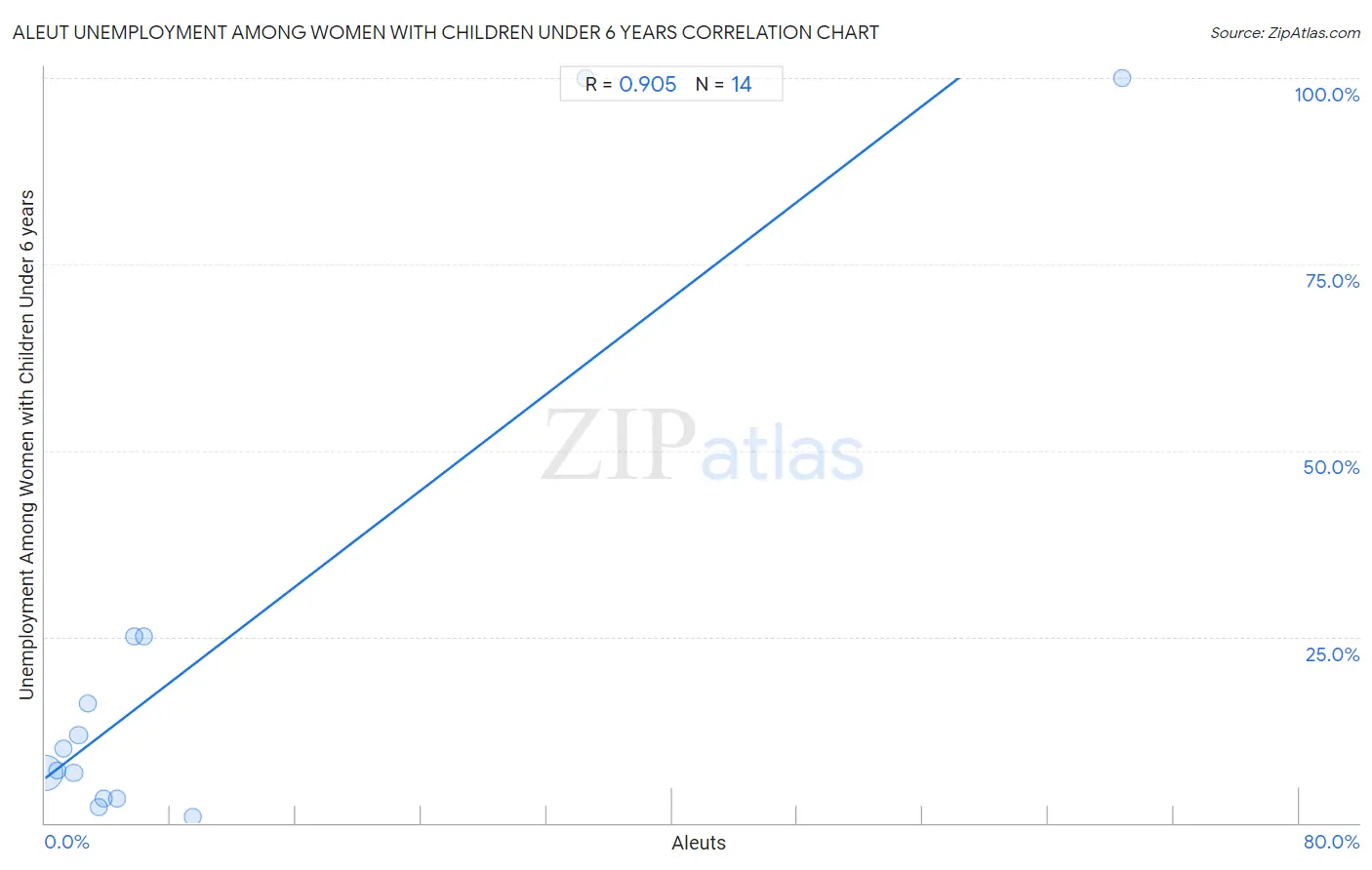Aleut Unemployment Among Women with Children Under 6 years
COMPARE
Aleut
Select to Compare
Unemployment Among Women with Children Under 6 years
Aleut Unemployment Among Women with Children Under 6 years
7.5%
UNEMPLOYMENT | WOMEN W/ CHILDREN < 6
76.0/ 100
METRIC RATING
150th/ 347
METRIC RANK
Aleut Unemployment Among Women with Children Under 6 years Correlation Chart
The statistical analysis conducted on geographies consisting of 56,364,668 people shows a near-perfect positive correlation between the proportion of Aleuts and unemployment rate among women with children under the age of 6 in the United States with a correlation coefficient (R) of 0.905 and weighted average of 7.5%. On average, for every 1% (one percent) increase in Aleuts within a typical geography, there is an increase of 1.6% in unemployment rate among women with children under the age of 6.

It is essential to understand that the correlation between the percentage of Aleuts and unemployment rate among women with children under the age of 6 does not imply a direct cause-and-effect relationship. It remains uncertain whether the presence of Aleuts influences an upward or downward trend in the level of unemployment rate among women with children under the age of 6 within an area, or if Aleuts simply ended up residing in those areas with higher or lower levels of unemployment rate among women with children under the age of 6 due to other factors.
Demographics Similar to Aleuts by Unemployment Among Women with Children Under 6 years
In terms of unemployment among women with children under 6 years, the demographic groups most similar to Aleuts are Colombian (7.5%, a difference of 0.010%), Immigrants from Peru (7.5%, a difference of 0.10%), Bangladeshi (7.5%, a difference of 0.11%), Immigrants from Brazil (7.5%, a difference of 0.12%), and Uruguayan (7.5%, a difference of 0.12%).
| Demographics | Rating | Rank | Unemployment Among Women with Children Under 6 years |
| Koreans | 81.3 /100 | #143 | Excellent 7.5% |
| Europeans | 79.1 /100 | #144 | Good 7.5% |
| Immigrants from Jordan | 78.9 /100 | #145 | Good 7.5% |
| Japanese | 78.9 /100 | #146 | Good 7.5% |
| Immigrants from Oceania | 78.4 /100 | #147 | Good 7.5% |
| Immigrants from Brazil | 77.3 /100 | #148 | Good 7.5% |
| Colombians | 76.1 /100 | #149 | Good 7.5% |
| Aleuts | 76.0 /100 | #150 | Good 7.5% |
| Immigrants from Peru | 74.9 /100 | #151 | Good 7.5% |
| Bangladeshis | 74.8 /100 | #152 | Good 7.5% |
| Uruguayans | 74.7 /100 | #153 | Good 7.5% |
| Northern Europeans | 74.3 /100 | #154 | Good 7.5% |
| South Americans | 74.1 /100 | #155 | Good 7.5% |
| Immigrants from Southern Europe | 73.2 /100 | #156 | Good 7.5% |
| Peruvians | 72.3 /100 | #157 | Good 7.5% |
Aleut Unemployment Among Women with Children Under 6 years Correlation Summary
| Measurement | Aleut Data | Unemployment Among Women with Children Under 6 years Data |
| Minimum | 0.016% | 0.80% |
| Maximum | 68.7% | 100.0% |
| Range | 68.7% | 99.2% |
| Mean | 10.3% | 22.7% |
| Median | 3.6% | 8.5% |
| Interquartile 25% (IQ1) | 1.8% | 3.3% |
| Interquartile 75% (IQ3) | 6.3% | 25.0% |
| Interquartile Range (IQR) | 4.5% | 21.7% |
| Standard Deviation (Sample) | 18.9% | 33.6% |
| Standard Deviation (Population) | 18.2% | 32.4% |
Correlation Details
| Aleut Percentile | Sample Size | Unemployment Among Women with Children Under 6 years |
[ 0.0% - 0.5% ] 0.016% | 55,496,423 | 6.6% |
[ 0.5% - 1.0% ] 0.75% | 242,090 | 7.0% |
[ 1.0% - 1.5% ] 1.19% | 107,994 | 10.0% |
[ 1.5% - 2.0% ] 1.82% | 395,784 | 6.7% |
[ 2.0% - 2.5% ] 2.14% | 64,307 | 11.8% |
[ 2.5% - 3.0% ] 2.70% | 9,199 | 16.0% |
[ 3.0% - 3.5% ] 3.42% | 5,584 | 2.1% |
[ 3.5% - 4.0% ] 3.70% | 15,501 | 3.3% |
[ 4.5% - 5.0% ] 4.59% | 12,620 | 3.3% |
[ 5.5% - 6.0% ] 5.67% | 1,234 | 25.0% |
[ 6.0% - 6.5% ] 6.33% | 964 | 25.0% |
[ 9.0% - 9.5% ] 9.38% | 12,618 | 0.80% |
[ 34.0% - 34.5% ] 34.47% | 235 | 100.0% |
[ 68.5% - 69.0% ] 68.70% | 115 | 100.0% |